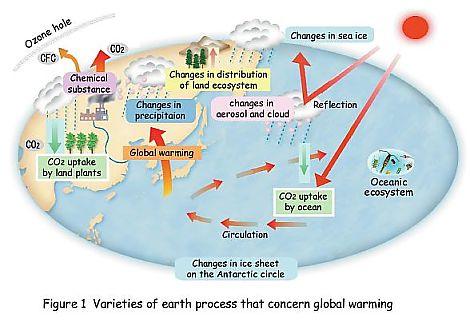Frontier Research System for Global Change
Climate change, such as global warming, is an outcome of complex interactions among climate, terrestrial and oceanic ecosystems, and chemical composition of atmosphere. The purpose of this project is to develop an integrated earth system model that can simulate these interactions, and provide reliable predictions for the change of global climate.
| In current studies of climate change, atmospheric CO2 concentration is first calculated using carbon emission scenarios and simple models of terrestrial and oceanic carbon budgets. The calculated CO2 concentration is then substituted into climate model, and predictions of climate are obtained. However, this approach do not consider any feedbacks between climate and carbon cycle; while increase of atmospheric CO2 concentration would cause global warming, global warming could in turn affects process of CO2 release and uptake by terrestrial and oceanic ecosystems (Fig. 1). For example, global warming would enhance decomposition of terrestrial organic matters, and thereby accelerating CO2 release from land surface. |  |
 |
Moreover, climate change could also affect concentration of troposphere ozon, which is another greenhouse effect gas. Therefore, for providing reliable predictions of climate change, it is strongly required that an integrated earth system model combines climate, carbon cycle, and chemical composition of atmosphere. Coupling a dynamical Ice sheet model would be also needed for a better prediction of sea level change. In this project, we are developing an integrated earth system model (Fig. 2), and planning to conduct simulation experiments on the Earth Simulator[link to other site]. |
Original figure 1 and 2 were drawn by S. Watanabe and M. Takigawa, respectively.